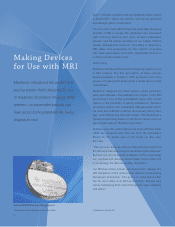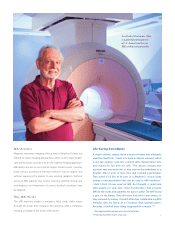Medtronic 2010 Annual Report Download - page 16
Download and view the complete annual report
Please find page 16 of the 2010 Medtronic annual report below. You can navigate through the pages in the report by either clicking on the pages listed below, or by using the keyword search tool below to find specific information within the annual report.
In 1981, we developed the world’s first fully programmable,
implantable drug pump designed to treat cancer pain.
Unlike oral medications that affect the whole body and typi-
cally require large doses, our drug pump requires a lower
effective dose because it delivers medication directly where
it’s needed—to the fluid-filled space in the spinal cord
where there are pain receptors.
Since then, we’ve developed other therapies using our drug
pump technology. They include therapies to treat the muscle
tightness associated with severe spasticity—from cerebral
palsy, traumatic brain or spinal cord injury, multiple sclerosis,
or stroke.
Today, we’re exploring another novel concept: drug pumps
to deliver medication to the brain—with the promise of new
therapies that may someday stop the progression of
diseases, not just treat their symptoms. We’re conducting
preclinical studies to demonstrate the feasibility of intracra-
nial or targeted brain infusion to treat chronic, debilitating
neurological conditions like Huntington’s, Parkinson’s, and
Alzheimer’s disease.
A closer look at our Alzheimer’s research demonstrates why
targeted drug delivery in the brain has so much potential.
“In the case of Alzheimer’s and other neurodegenerative
diseases, deterioration is generally localized within the brain,“
said Lisa Shafer, Ph.D., Principal Scientist and Research
Manager in our Neuromodulation business. “Developing
targeted therapies that can help address these debilitating
neurological con ditions is challenging due to the barrier that
surrounds the brain,” she said.
Investigating
Targeted Drug
Delivery to Treat
Neurodegeneration
In 1981, Medtronic introduced a novel
medical concept: targeted drug delivery.
Today, we’re exploring the technology
as a way to overcome the challenges of
the body’s blood-brain barrier.
In a preclinical study, Medtronic researchers demonstrated that delivering antibodies directly to the brain (C) reduced the plaque-forming protein
thought responsible for Alzheimer’s disease better than antibodies delivered systemically (B). Image (A) is a non-treated brain.
12
























